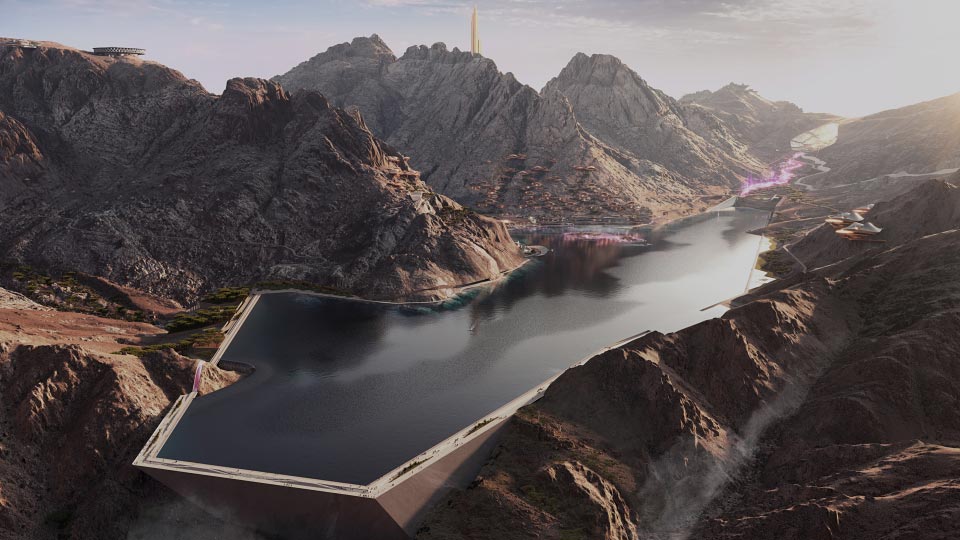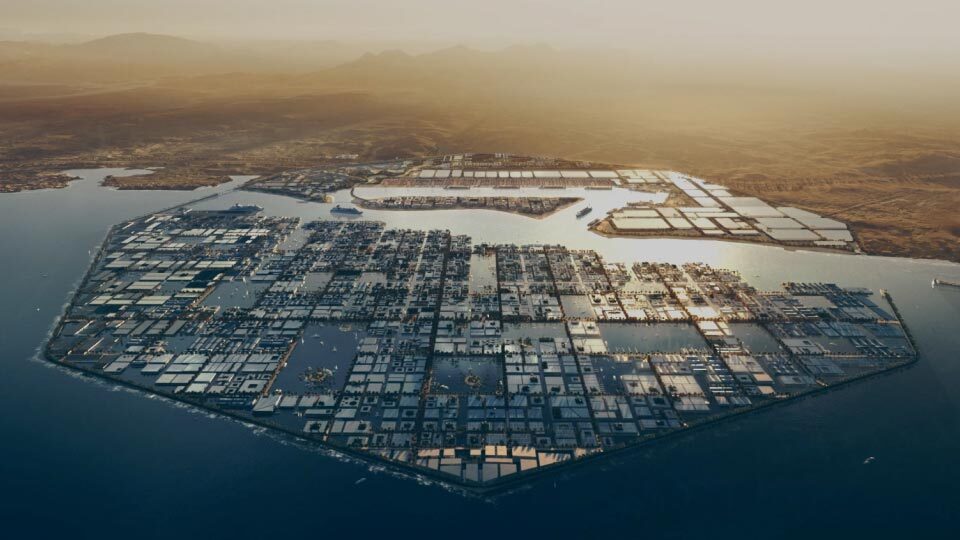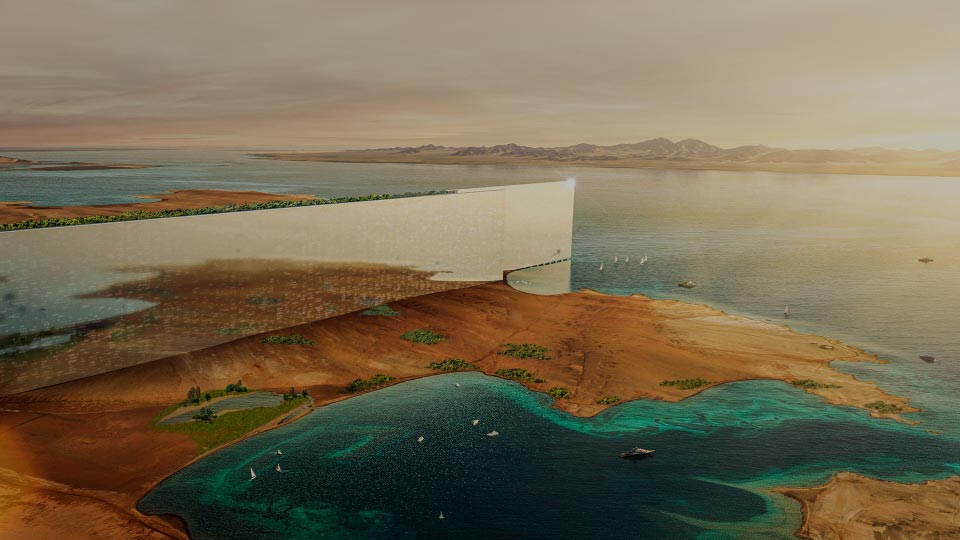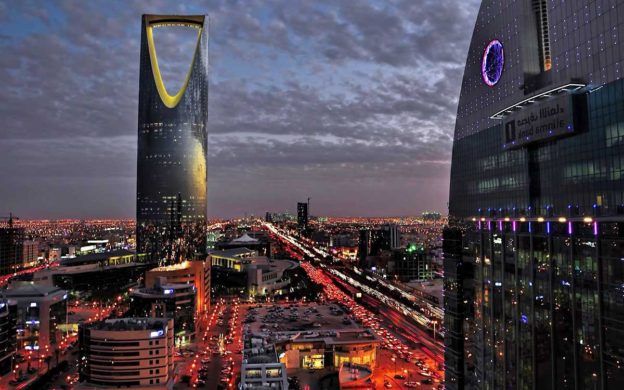Saudi Arabia pioneers the future of sustainable living with the release of NEOM, a smart city that preserves 95% of the nature within the region.
As humans hover between reality and the metaverse in the coming decades, they will look at the pharaonic climate age utopia that Saudi Crown Prince Mohammed bin Salman (MBS) is building in a desert on the Red Sea as a marker of what we thought in 2022 would be an ideal carbonless community. MBS’s over $1 trillion NEOM development is a package of gigantic civilization-stretching projects that are his Jetsons-like image of the future. While George Jetson flying his car around space is still a fantasy, the space age communications and convenience of the 1960’s cartoon pale to what is available today.
What is on the mind of MBS as he seeks to build the greatest structures in the world since the Great Pyramid? He imagines “portals” connecting the digital to the physical that will somehow allow us to live sustainably and thrive in the earth’s atmosphere that is becoming increasingly inhospitable to humans. They are the Crown Prince’s vision of the end of the road for the world’s largest supplier of fossil fuel.
It is a high-density city spanning 170 kilometers in length, 200 meters in width and 500 meters above sea level in height. To put that into perspective. It would be as long as Long Island, NY and as tall as the Empire State Building.
NEOM, shorthand for “new future,” is a massive city development project meant to provide a solution to the looming threat of climate change and habitat loss. NEOM spans three separate regions: TROJENA (a mountainous year-round tourist destination), OXAGON (an industrial floating structure in the Red Sea) and – most famously – THE LINE. With towering mirrored walls to reflect the surrounding desert environment, THE LINE looks like a scene out of the 1982 film Blade Runner. It is a high-density city spanning 170 kilometers in length, 200 meters in width and 500 meters above sea level in height. To put that into perspective. It would be as long as Long Island, NY, and as tall as the Empire State Building.
The Vision
TROJENA: The Gstaad of Saudi Arabia

Claimed to become the pinnacle of mountain living – a high-tech destination with year-round skiing and adventure sports – TROJENA will somehow be completed by 2026. TROJENA plans to be a place of luxury for both tourists and citizens with chalets, mansions and apartments for housing. There you will be able to have it all: the “buzz of culture” or the “serenity of nature” and “the world’s most advanced health and well-being center” – clearly, MBS has been watching James Bond movies. The ecotourism revenue will be used to support Saudi Arabia’s “economic diversification.” In a press release, MBS, who is also Chairman of the NEOM Company Board of Directors, announced, “TROJENA will redefine mountain tourism for the world by creating a place based on the principles of ecotourism, highlighting our efforts to preserve nature and enhance the community’s quality of life.”
OXAGON: “An open book for pivotal moments in history to be written”

With a population of 90 thousand and spanning 48 square kilometers, the city of OXAGON will be the largest floating structure in the world. Promotional material celebrates the city as “a purpose-built environment that fosters creativity and inspires collaboration; a place where if you have a dream you will find everything you need to make it happen; and where making the biggest impact in the world makes the smallest impact on the planet […] the place where ideas will change the world.”
Its location will be on the Red Sea, attached to the coast of NEOM, providing ample access to cargo transport through the Suez Canal. The detailed organization of the area provides different manufacturing centers, ports, residential villages and even an oceanographic research center. The city’s first residents are expected quite soon – in 2024 – with onshore development completed by 2030.
Most impressively, OXAGON will house a hydrogen production plant. By refining seawater, OXAGON will produce hydrogen that can be converted into ammonia which can then be exported as a renewable fuel. Oxygen, a byproduct of the process, will be used to feed greenhouses and grow food for the people in NEOM. The creation of this city marks Saudi Arabia’s transition from a reliance on oil exports to renewable energy exports.
THE LINE

THE LINE will have no cars, no emissions, run completely on renewable energy and house nine million people. 95% of nature in NEOM will also be preserved as THE LINE condenses urban sprawl to a mere 34 square kilometers. Comparatively, New York City has a population of 8.38 million people and spans 784 square kilometers.
The concept designs not only preserve nature but incorporate it among the buildings to enhance air filtration, internal climate and quality of life. A five-minute walk from a residential area takes you to all necessary facilities, from leisure, health or workplace. If someone needs to travel to the other end of the city, a high-speed rail takes them over in a mere 20 minutes. The city also features smart AI to handle automated services.
The Reality
As impressive as THE LINE appears, the details of its construction have not been shared. Will the high-speed rail handle garbage collection and cargo transport? Three hundred eighty thousand jobs will be created by 2030 through the creation of the city, but once the city is built, who will be permitted to move into the city, and will those construction jobs disappear? What animals are native to NEOM, and will THE LINE impact any migration paths? Will OXAGON impact any sea life below it?
NEOM will someday be judged as the defining project that marks the world’s transition to sustainable living or a colossal act of failed hubris.
Additionally, there have been criticisms of the Saudi Arabian government regarding its treatment of women and the assassination of journalist Jamal Khashoggi. Will the new region be under the same governmental leadership? And, as Saudi Arabia is historically known for its reliance on the oil industry, will the sustainability goals of the project ever be sacrificed for the economic pursuits of the oil industry? OXAGON provides hopeful answers to this last question, but it can only be truly answered once the three regions of NEOM have been completed.
Leave no doubt, MBS is a risk taker. NEOM will someday be judged as a defining project that marked the the beginning of world’s transition to a new form of sustainable living or a colossal act of failed hubris.
Regardless of these concerns, NEOM still is an important indicator of the state of the climate. In order to protect the world from the effects of climate change, conservationists call for 30% of the world to be protected by 2030 and for 50% of the world by 2050. NEOM provides a radically innovative solution to such a suggestion. The cities are a potential technological wonder indicative of how the world must adapt to preserve the Earth. Despite its cliche grandiosity, NEOM is a creative call to action for other countries to start thinking outside the box for human habits and environmental solutions. Perhaps other countries will follow suit, and more smart cities will be designed in response to climate decline.





